Michael Brown shooting: Who's who in Ferguson
August 20, 2014 -- Updated 1447 GMT (2247 HKT)
Source: CNN
First, it was the police
chief who took charge and stumbled. Then, the governor entered the
picture and brought on a Ferguson son to head security. The feds have
also stepped in, with Attorney General Eric Holder stopping by Wednesday
to check up on their investigation.
Here's a look at the
players who have shaped the city's response to the death of Michael
Brown, an unarmed black teenager, at the hands of a white police
officer.
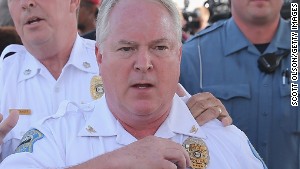
.
WHO:
Ferguson Police Chief Thomas Jackson
What he did:
From the start the chief
said his department -- which handed off the local investigation to St.
Louis County -- would release information as it received it. It would be
a slow process, he warned.
.
How it played out:
From the beginning the chief was slammed for just how slow that information came out.
The big one was the
identity of the officer. It took six days before the name -- Darren
Wilson -- was revealed. Cops said it was because he received death
threats. Critics denounced the delay as a PR stumble that coincided with
another one -- the release of a video that police said showed Brown
robbing a store minutes before he was shot.
Critics lambasted the disclosure of the video as character assassination. The chief said he had to do it.
Jackson was also criticized for his department's response to the protests in the days immediately after Brown's death.
As the demonstrations
grew more heated, police used on the crowd tear gas, pepper bullets and
what looked like stun grenades. Some police rolled into action sitting
on an armored personnel carrier.
.
How it was received:
"You're in trouble when
your SWAT team is on the front line of dealing with a civil
disturbance," said retired Lt. Gen. Russell Honoré, a CNN analyst.
Jackson said police had to protect themselves and that some of the protesters were throwing fire bombs.
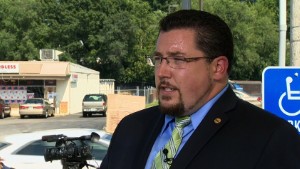
.
WHO:
Ferguson Mayor James Knowles
What he did:
The young mayor has
tried to tell people unfamiliar with the town he has lived in his whole
life that it's not the crucible of racial tensions it appears to be to
those outside the city limits.
"I've lived here 35
years. There's always been a strong African-American presence," he told
CNN. "We've never seen this kind of violence, never seen this kind of
frustration or tension between the races."
.
How it played out:
The mayor has kept
largely out of the spotlight, letting other officials take care of news
conferences and major public appearances. Instead he's gone on
one-on-one interviews and given updates on how his town reacted.
.
How it was received:
His low profile may be
helping him to avert criticism over actions taken since Brown's
shooting, but Knowles has been in the line of fire with other officials
over the disproportionate number of white officers on the police force
of his majority African-American town.
He has defended the imbalance, telling the St. Louis Post-Dispatch that every time a position frees up for a new officer that the city rushes out to find an African-American to fill it.
Ferguson is less
successful at getting such recruits than neighboring departments, which
are better at recruiting and offer higher salaries, he said.
He has also come under
criticism for a racial imbalance in the city council, where five of six
members are white. Knowles, first elected in 2011, told the
Post-Dispatch that he ran for election unopposed.
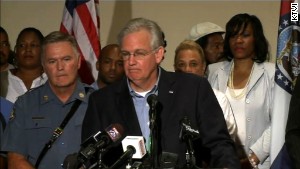
.
WHO:
Missouri Gov. Jay Nixon
What he did:
First he stayed out
things, and when he did go, he visited the neighboring town of
Florissant, not Ferguson. Then he made the decision to bring in the
highway patrol.
.
How it played out:
Poorly. The violent
protests were getting more violent and police were drawing more
criticism for its tactics. And the media, local and national, was
asking: Where's the governor?
The Washington Post
wrote: "A week ago, Jay Nixon was a Democratic governor with a promising
political future. Today, he's a guy with a rocky recent past."
Once Nixon stepped into the fray, he didn't go to the shooting scene and was accused of avoiding ground zero.
.
How it was received:
Attendees interjected at a meeting Nixon held
at a local church to announce a controversial curfew. They demanded he
charge Wilson with murder. They accused law enforcement of triggering
nightly violence with militaristic tactics.
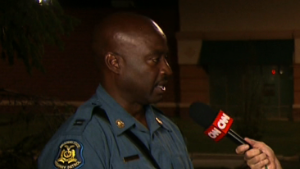
.
WHO:
Missouri State Highway Patrol Capt. Ron Johnson
What he did:
When it seemed like the
situation in Ferguson was doomed to grow out of control, the governor
wrested oversight of the security force and gave it to Johnson, a
Ferguson native. And at first it seemed the captain had turned the tide.
He walked with
protesters, turned a news conference into a community forum, seemed like
a good guy who was a bridge between community and government.
On Sunday, Johnson
appeared at a church rally in support of the Johnson family. With a
solemn and pained expression, he said he was sorry to the parents, and
he explained that he, too, was the father of a black son who wears saggy
pants and has tattoos. "My baby," he called his boy.
.
How it played out:
Johnson has been open
with the public as he has been trying to calm the uneasiness in the air.
And even as tension still permeates the town, residents feel a little
better because they know the captain will be out there. He's one of
them, and they can ask him their questions.
.
How it was received:
Well -- except for minor hiccups.
Johnson was welcomed with open arms last week.
But security forces
under his command have lobbed tear gas and stun grenades at rowdy
protesters, who toss rocks and Molotov cocktails at them. That may have
soured some of the initial sentiments.
CNN's Jake Tapper echoed the frustrations of many.
"Absolutely there have
been looters, absolutely over the last nine days there has been
violence, but there is nothing going on in this street right now that
merits this scene out of Bagram (Afghanistan). Nothing."
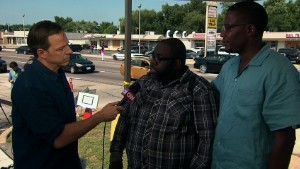
.
WHO:
Attorney Malik Shabazz
What he did:
He's the national
president and founder of Black Lawyers for Justice. He has been trying
to help the community stay away from rowdy elements, who he says are not
from Ferguson.
He told CNN on Tuesday
that he came to Ferguson as a "man and a father figure." He felt
confident that he and others could have a good influence on young men.
.
How it played out:
Shabazz insists "provocateurs" from outside the community
have caused the problems. He accused them of being planted in the crowd
to make demonstrators look bad and turn public opinion in favor of the
police.
"We can't allow this movement to be destroyed," he said.
On Monday, when rocks and tear gas canisters flew, he was out with a bullhorn urging people to keep calm.
.
How it was received:
Despite Shabazz' efforts on behalf of Ferguson protesters, he has a very controversial past.
The former leader of the New Black Panther Party is a black supremacist, with a history of anti-Semitic remarks, according to the Southern Poverty Law Center, a civil rights group that guards the rights of minorities and monitors hate groups.
Shabazz has often railed against white people, calling them inherently evil, the SPLC said.
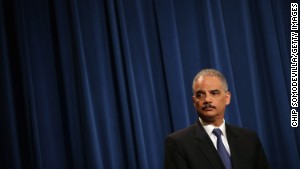
.
WHO:
U.S. Attorney General Eric Holder
What he did:
The first black U.S. attorney general will visit Ferguson on Wednesday.
He's checking up on the Justice Department's civil rights investigation
into the shooting. He said he'll also meet with community leaders.
The FBI has about 40
investigators in Ferguson, Holder wrote in a letter to the people of
Ferguson. He says: "We hope that the independence and thoroughness of
our investigation will bring some measure of calm" to the city.
.
How it's playing out:
Holder wrote that the investigation had already made good progress, but indicated it was not going to wrap up anytime soon.
.
How it's being received:
It's hard to tell yet.
In civil rights issues, he is considered President Barack Obama's
ambassador. Some people get nervous when they see him coming. Under Holder, the Justice Department has intensified its scrutiny of police departments, launching 20 investigations of police practices and alleged discriminatory enforcement patterns in the past five years.
That's more than twice the number of such probes in the previous five years.

.
WHO:
St. Louis County Prosecuting Attorney Robert McCulloch
What he did:
He's been the county's
top prosecutor since 1991 and has been easily re-elected five times.
This year, he actually had a challenger in his primary, which he handily
won just a few days before Brown was killed.
After Gov. Nixon
replaced the St. Louis County Police with the Missouri State Highway
Patrol for security last week, McCulloch said the initial law
enforcement response to the shooting was excessive.
McCulloch told CNN affiliate KMOV that the governor had "no legal authority" to make such a move.
.
How it's playing out:
McCulloch steps before a
grand jury Wednesday with the assignment of making his case against
Wilson. He has eyewitness accounts of Brown's shooting as well as
Wilson's own account of what happened.
Beyond that, much of the
evidence is not yet ready, and a CNN legal analyst said it could take a
long time for crime labs to process it.
.
How it's being received:
Critics have said he could be biased in favor of the man he is tasked with prosecuting.
He's the son of a cop who was killed at work 50 years ago. His mother
was a clerk for the St. Louis Police Department, and three relatives
were also with SLMPD.
He would have been an officer too, but cancer took one of his legs.
Missouri State Sen.
Jamilah Nasheed and 26,000 other people have signed a petition calling
for McCulloch to be removed from the case -- and a special prosecutor
assigned.
Governor Nixon has refused to do so.

No comments:
Post a Comment